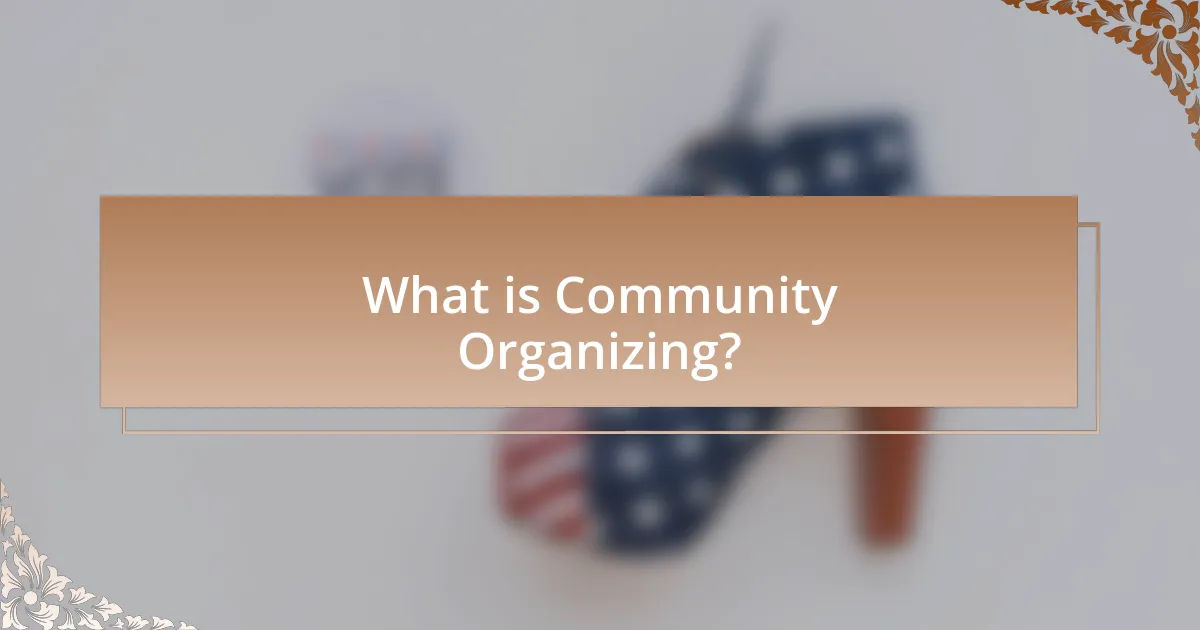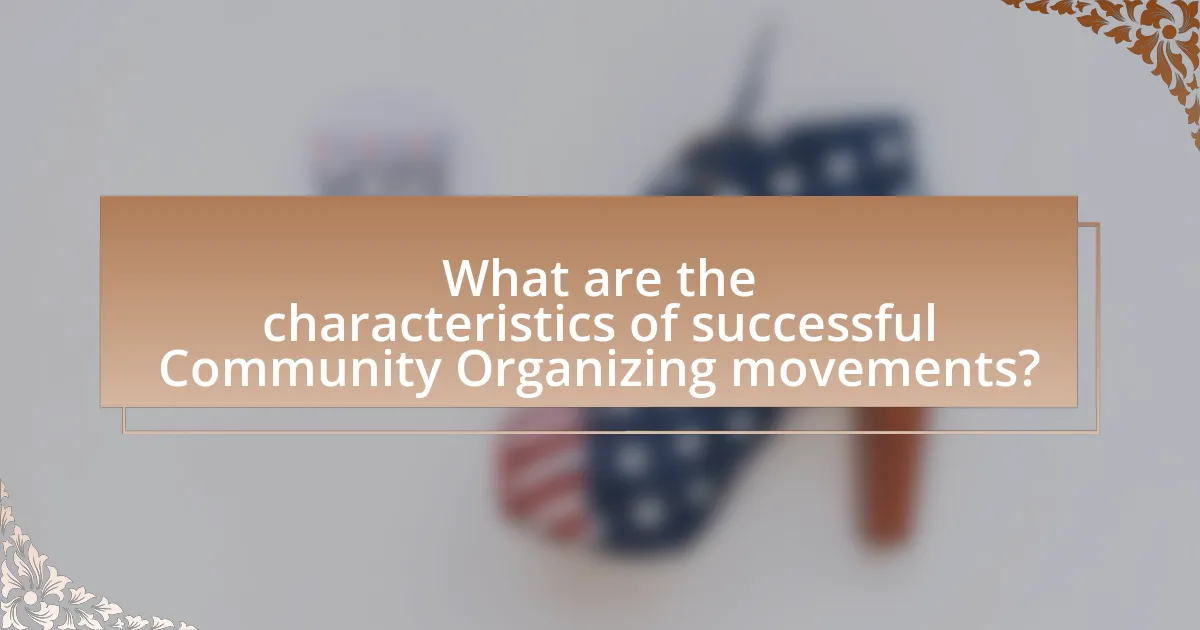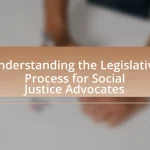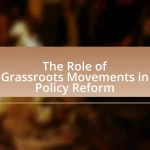Community organizing is a collaborative process where individuals unite to address shared issues and advocate for social change. This article explores the principles, functions, and significance of community organizing, highlighting its historical impact through movements like the Civil Rights Movement. Key characteristics of successful organizing efforts, such as strong leadership, grassroots participation, and effective communication strategies, are examined, along with the challenges organizers face and methods to overcome them. Additionally, the article discusses best practices for building coalitions and enhancing community engagement, drawing lessons from past movements to inform contemporary organizing efforts.

What is Community Organizing?
Community organizing is a process through which individuals come together to identify common issues, build relationships, and take collective action to address those issues. This approach empowers communities by fostering collaboration and mobilizing resources to create social change. Historical examples, such as the Civil Rights Movement in the United States, demonstrate the effectiveness of community organizing in achieving significant societal transformations, highlighting its role in advocating for justice and equality.
How does Community Organizing function in society?
Community organizing functions in society by mobilizing individuals to collectively address shared issues and advocate for social change. This process fosters community engagement, empowers marginalized groups, and builds networks of support, enabling participants to influence local policies and practices. For instance, successful movements like the Civil Rights Movement utilized community organizing to challenge systemic injustices, leading to significant legislative changes such as the Civil Rights Act of 1964. This demonstrates that community organizing not only raises awareness but also creates tangible outcomes through collective action and solidarity.
What are the key principles of Community Organizing?
The key principles of Community Organizing include empowerment, participation, and collaboration. Empowerment focuses on enabling individuals and groups to gain control over their lives and influence decisions affecting them. Participation emphasizes the active involvement of community members in the organizing process, ensuring that their voices are heard and valued. Collaboration involves building partnerships among diverse stakeholders to achieve common goals, fostering a sense of unity and shared purpose. These principles are foundational in creating effective community movements, as evidenced by successful initiatives like the Civil Rights Movement, which mobilized individuals to advocate for social change through collective action.
How do these principles guide successful movements?
Principles guide successful movements by providing a framework for effective strategy, unity, and action. These principles, such as clear goals, inclusive participation, and grassroots mobilization, ensure that movements remain focused and adaptable. For instance, the Civil Rights Movement in the United States exemplified these principles through its clear objectives of desegregation and voting rights, which galvanized widespread support and participation across diverse communities. This strategic clarity, combined with grassroots organizing, enabled the movement to achieve significant legislative victories, such as the Civil Rights Act of 1964.
Why is Community Organizing important?
Community organizing is important because it empowers individuals and groups to collectively address social issues and advocate for change. This process fosters a sense of agency among community members, enabling them to identify their needs and mobilize resources effectively. Historical examples, such as the Civil Rights Movement, demonstrate that organized communities can challenge systemic injustices and achieve significant policy reforms, illustrating the effectiveness of collective action in driving social progress.
What impact does Community Organizing have on local communities?
Community organizing significantly enhances local communities by fostering collective action and empowering residents to address shared issues. This process leads to increased civic engagement, as individuals become more involved in decision-making and advocacy efforts. For instance, studies show that neighborhoods with active community organizing initiatives experience improved social cohesion and greater access to resources, such as healthcare and education. Research conducted by the National Community Organizing Network indicates that organized communities are more successful in influencing local policies, resulting in tangible benefits like increased funding for public services and infrastructure improvements.
How does Community Organizing empower marginalized groups?
Community organizing empowers marginalized groups by facilitating collective action and amplifying their voices in decision-making processes. This approach enables individuals from these groups to unite around common issues, fostering a sense of solidarity and shared purpose. For instance, the Civil Rights Movement in the United States demonstrated how organized efforts led to significant legislative changes, such as the Voting Rights Act of 1965, which aimed to eliminate racial discrimination in voting. Additionally, community organizing provides training and resources that enhance leadership skills among marginalized individuals, equipping them to advocate effectively for their rights and needs. This empowerment is evidenced by the increased participation of marginalized communities in local governance and policy-making, leading to more equitable outcomes.

What are the characteristics of successful Community Organizing movements?
Successful community organizing movements are characterized by strong leadership, clear goals, grassroots participation, and effective communication. Strong leadership ensures that the movement has direction and can mobilize resources effectively, as seen in the Civil Rights Movement led by figures like Martin Luther King Jr. Clear goals provide a shared vision that unites participants, exemplified by the specific objectives of the Women’s Suffrage Movement. Grassroots participation fosters inclusivity and empowers community members, which was crucial in the labor movements of the early 20th century. Effective communication strategies, such as social media outreach in recent movements like Black Lives Matter, enhance visibility and engagement. These characteristics collectively contribute to the success and sustainability of community organizing efforts.
What strategies do successful movements employ?
Successful movements employ strategies such as grassroots mobilization, coalition building, and effective communication. Grassroots mobilization involves engaging community members at the local level to foster participation and ownership, exemplified by the Civil Rights Movement, which utilized local leaders to organize protests and voter registration drives. Coalition building enhances the movement’s strength by uniting diverse groups with shared goals, as seen in the Women’s March, which brought together various organizations advocating for women’s rights. Effective communication, including the use of social media and traditional media, allows movements to spread their message widely and rally support, demonstrated by the Arab Spring, where social media played a crucial role in organizing protests and disseminating information. These strategies collectively contribute to the success of movements by increasing visibility, fostering solidarity, and mobilizing resources.
How do these strategies differ across various movements?
Strategies in community organizing differ significantly across various movements due to their unique goals, cultural contexts, and target audiences. For instance, the civil rights movement employed grassroots mobilization and nonviolent protest to challenge systemic racism, while the environmental movement often focuses on policy advocacy and scientific research to address climate change. Additionally, labor movements typically emphasize collective bargaining and worker rights, contrasting with feminist movements that may prioritize awareness campaigns and legislative reforms. These differences are evident in the varying tactics used, such as direct action in social justice movements versus lobbying in political movements, reflecting the specific needs and circumstances of each movement.
What role does leadership play in these strategies?
Leadership is crucial in community organizing strategies as it provides direction, motivation, and cohesion among participants. Effective leaders articulate a clear vision, mobilize resources, and foster collaboration, which are essential for achieving collective goals. For instance, leaders in successful movements like the Civil Rights Movement effectively galvanized community support and maintained focus on key objectives, demonstrating that strong leadership can significantly enhance the impact and sustainability of organizing efforts.
What challenges do Community Organizers face?
Community organizers face several significant challenges, including limited resources, resistance from stakeholders, and the need for effective communication. Limited resources often hinder their ability to mobilize communities and sustain initiatives, as many organizers work with minimal funding and personnel. Resistance from stakeholders, such as local governments or businesses, can obstruct efforts to implement change, as these entities may prioritize their interests over community needs. Additionally, effective communication is crucial; organizers must convey complex issues in a way that resonates with diverse community members, which can be difficult given varying levels of education and engagement. These challenges are well-documented in studies on community organizing, highlighting the multifaceted nature of the work and the necessity for strategic approaches to overcome obstacles.
How can these challenges be overcome?
Challenges in community organizing can be overcome through strategic coalition-building, effective communication, and grassroots mobilization. By forming alliances with diverse stakeholders, organizers can pool resources and amplify their voices, which enhances their collective impact. Effective communication ensures that messages resonate with the community, fostering engagement and participation. Grassroots mobilization empowers individuals by encouraging local leadership and ownership of initiatives, which has been shown to increase sustainability and effectiveness in movements, as evidenced by the success of the Civil Rights Movement in the United States, where local leaders played crucial roles in driving change.
What resources are available to support Community Organizers?
Community organizers can access a variety of resources to enhance their effectiveness, including training programs, funding opportunities, and networking platforms. Training programs, such as those offered by the National Organizers Alliance, provide essential skills in grassroots mobilization and advocacy. Funding opportunities are available through organizations like the Ford Foundation, which supports community-led initiatives with grants. Additionally, networking platforms, such as the Grassroots Organizing Network, facilitate connections among organizers, allowing for the sharing of best practices and collaborative efforts. These resources collectively empower community organizers to drive social change effectively.

What lessons can be learned from historical Community Organizing movements?
Historical Community Organizing movements teach several key lessons: the importance of grassroots mobilization, the effectiveness of coalition-building, and the necessity of sustained engagement. Grassroots mobilization, as seen in the Civil Rights Movement, demonstrates that local communities can drive significant social change when they unite around common goals. Coalition-building is exemplified by the United Farm Workers, which successfully brought together diverse groups to advocate for labor rights, highlighting that collaboration enhances impact. Sustained engagement is evident in the anti-apartheid movement, where continuous activism over decades was crucial for achieving political change in South Africa. These movements illustrate that strategic organization, unity, and persistence are vital for successful community advocacy.
What are some notable examples of successful movements?
Notable examples of successful movements include the Civil Rights Movement in the United States, which led to significant legislative changes such as the Civil Rights Act of 1964 and the Voting Rights Act of 1965, effectively dismantling institutionalized racial segregation and discrimination. Another example is the Women’s Suffrage Movement, which culminated in the passage of the 19th Amendment in 1920, granting women the right to vote in the U.S. Additionally, the LGBTQ+ rights movement has achieved milestones such as the legalization of same-sex marriage in numerous countries, including the U.S. in 2015 through the Supreme Court ruling in Obergefell v. Hodges. Each of these movements mobilized large groups of people, utilized strategic advocacy, and resulted in significant societal and legal changes.
What tactics were employed in these movements?
Successful movements employed a variety of tactics including grassroots mobilization, coalition building, and strategic nonviolent resistance. Grassroots mobilization involved engaging community members at the local level to foster participation and ownership of the movement, exemplified by the Civil Rights Movement’s use of local organizing committees. Coalition building was crucial, as seen in the labor movements, where diverse groups united to amplify their voices and resources. Strategic nonviolent resistance, such as sit-ins and marches, effectively drew public attention and pressured authorities, demonstrated by the success of the Montgomery Bus Boycott, which led to significant legal changes. These tactics collectively contributed to the effectiveness and impact of the movements.
How did these movements achieve their goals?
These movements achieved their goals through strategic grassroots organizing, coalition-building, and effective communication. For instance, the Civil Rights Movement utilized nonviolent protests and legal challenges to dismantle segregation laws, leading to significant legislative changes such as the Civil Rights Act of 1964. Additionally, the Women’s Suffrage Movement employed advocacy, public demonstrations, and lobbying efforts, culminating in the ratification of the 19th Amendment in 1920, which granted women the right to vote. These examples illustrate how organized efforts, clear messaging, and persistent activism can lead to substantial societal change.
What can contemporary organizers learn from past movements?
Contemporary organizers can learn the importance of grassroots mobilization from past movements. Historical examples, such as the Civil Rights Movement, demonstrate that effective organizing relies on building strong community ties and engaging individuals at the local level. The success of the Montgomery Bus Boycott, which involved extensive community participation and coordination, illustrates how collective action can lead to significant social change. Additionally, past movements highlight the necessity of clear messaging and strategic communication, as seen in the Women’s Suffrage Movement, where targeted campaigns effectively raised awareness and garnered support for voting rights. These lessons emphasize that contemporary organizers should prioritize community engagement and strategic communication to achieve their goals.
How can historical successes inform current practices?
Historical successes can inform current practices by providing proven strategies and frameworks that have effectively mobilized communities. For instance, the Civil Rights Movement utilized grassroots organizing, coalition-building, and nonviolent protest, which are still relevant techniques for contemporary social movements. Research indicates that movements that adapt successful historical tactics, such as those employed by the Women’s Suffrage Movement, can achieve greater impact and engagement. By analyzing these past successes, current organizers can refine their approaches, ensuring they resonate with modern audiences while maintaining the core principles that led to historical victories.
What mistakes should modern organizers avoid?
Modern organizers should avoid the mistake of neglecting community engagement. Effective community organizing relies on building relationships and trust within the community, which is essential for mobilizing support and ensuring participation. Research shows that movements with strong grassroots involvement, such as the Civil Rights Movement, achieved significant success by prioritizing community voices and needs. Additionally, organizers should not overlook the importance of clear communication; miscommunication can lead to misunderstandings and disengagement. Studies indicate that transparent messaging fosters a sense of ownership among community members, enhancing their commitment to the cause. Lastly, modern organizers must avoid the pitfall of failing to adapt strategies based on feedback and changing circumstances, as flexibility has proven crucial in the success of various social movements.
What are best practices for effective Community Organizing?
Best practices for effective community organizing include building strong relationships, engaging diverse stakeholders, and fostering inclusive participation. Strong relationships create trust and collaboration, which are essential for mobilizing community members. Engaging diverse stakeholders ensures that various perspectives are represented, enhancing the effectiveness of initiatives. Fostering inclusive participation allows for broader community input, leading to more sustainable outcomes. Research shows that successful movements, such as the Civil Rights Movement, utilized these practices to achieve significant social change, demonstrating their effectiveness in real-world scenarios.
How can organizers build strong coalitions?
Organizers can build strong coalitions by fostering trust and collaboration among diverse groups. This involves identifying common goals, facilitating open communication, and ensuring inclusive participation. Research indicates that successful coalitions often prioritize relationship-building activities, such as joint training sessions and community events, which enhance mutual understanding and commitment. For example, the Coalition for Immigrant Rights in Los Angeles effectively united various organizations by focusing on shared objectives and creating a platform for dialogue, resulting in increased advocacy power and community engagement.
What methods enhance community engagement and participation?
Methods that enhance community engagement and participation include participatory planning, collaborative decision-making, and the use of technology for communication. Participatory planning involves community members in the decision-making process, ensuring their voices are heard and valued, which has been shown to increase investment in community initiatives. Collaborative decision-making fosters partnerships among stakeholders, leading to more inclusive and representative outcomes. The use of technology, such as social media platforms and community apps, facilitates real-time communication and mobilization, making it easier for individuals to engage and participate in community activities. Research indicates that communities employing these methods experience higher levels of civic involvement and satisfaction, as evidenced by studies conducted by the National Civic League, which highlight the positive correlation between engagement strategies and community resilience.










